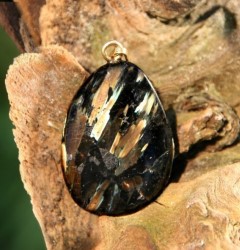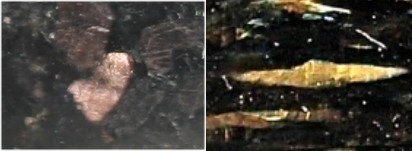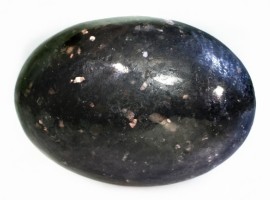Many rocks, previously known primarily in the stonemasonry industry, are recently seen in the mineral trade as polished or tumbled stones. This development is undoubtedly an enrichment for lovers of beautiful rocks. Unfortunately, these decorative rocks are rarely labeled with a mineralogically/petrographically correct name. This is also the case with a dark, almost black rock with copper-colored sprinkles, which is often wrongly offered in the mineral trade under the name "Nuumite".
Bronzite-Gabbro (Norite)
The dark, almost black rock has been quarried since 1988 near the village of Chimakurthy (near Ongole) in the state of Andhra Pradesh in India. In 44 quarries spread over an area of more than 160 hectares, around 20,000 to 25,000 cubic meters of the decorative rock are extracted every month. It is marketed under the name "Black Galaxy" or "Star Galaxy". Under these names it is known in the stonemasonry industry as a decorative stone, which can be easily processed into kitchen tiles and countertops.
Mineralogically, it is a gabbro, a quartz-poor igneous rock consisting essentially of plagioclase feldspar (labradorite) and pyroxene minerals. The almost black intrinsic color is caused by the intercalation of dark ore minerals (mainly magnetite). Between the Labradorite crystals are roundish inclusions of the pyroxene mineral Bronzite. Depending on the viewing direction these bronzite inclusions shine golden or copper colored and create an interesting optical effect.
Due to the specific mineral composition, the rock is called "bronzite gabbro".The dark, almost black rock has been mined since 1988 near the village of Chimakurthy (near Ongole) in the state of Andhra Pradesh in India. In 44 quarries spread over an area of more than 160 hectares, around 20,000 to 25,000 cubic meters of the decorative rock are extracted every month. It is marketed under the name "Black Galaxy" or "Star Galaxy". Under these names it is known in the stonemasonry industry as a decorative stone, which can be easily processed into kitchen tiles and countertops.
Mineralogically, it is a gabbro, a quartz-poor igneous rock consisting essentially of plagioclase feldspar (labradorite) and pyroxene minerals. The almost black intrinsic color is caused by the intercalation of dark ore minerals (mainly magnetite). Between the Labradorite crystals are roundish inclusions of the pyroxene mineral Bronzite. Depending on the viewing direction these bronzite inclusions shine golden or copper colored and create an interesting optical effect.
Due to the specific mineral composition, the rock bears the name "bronzite gabbro".
Nuumite (Amphibolite-Schist)

Nuumite (amphibolite schist) always shows stalky, iridescent sheaves
Image: K. Sieber, www.makrogalerie.de
Nuumite is a dark gray to almost black rock that has been mined since 1982 at a total of eight sites near the town of Nuuk in southwestern Greenland. With an age of more than 2.8 billion years, nuumite is one of the world's oldest commercial gemstones. A shiny gold mineral also occurs in this rock, but unlike bronzite, it forms elongated crystals.
The decorative rock originates from an amphibolite schist lenticularly embedded in a quartz-cordierite gneiss. The metamorphic rock, consists of at least 80% of one or more minerals of the amphibole family. In the nuumite, the two amphibole minerals anthophyllite and gedrite are intergrown in the form of very fine lamellae. Due to the reflection of the light at these lamellas and the resulting overlapping of the wavelengths, iridescent light appearances in golden-yellow or also variegated colors occur. The size of the amphibole crystals varies from less than 1 mm up to more than 10 cm. Common accompanying minerals are quartz, pyrite, chalcopyrite and magnetite.
Differentiation of bronzite gabbro from nuumite
Both rocks have a dark to almost black base color, with shiny gold to copper reflective areas. However, the mineralogical composition and the way of formation of these rocks is very different, so that they must not be equated in any case.
Visual distinction:

Shape and color of the shiny inclusions are important for diagnosis (left: bronzite gabbro; right nuumite).
Image: K. Sieber, www.makrogalerie.de
The most important and easiest distinguishing feature is the appearance of the shiny inclusions. In bronzite gabbro, these inclusions are more rounded and shiny in copper to bronze colors. In Nuumite, the lustrous inclusions are elongated, parquet-like or stalk-like, with golden yellow colors. The shape and color of the distinctive inclusions are clearly different from each other when looked at closely. The reason for the recurring misnomer is probably that Nuumite is much rarer and thus more expensive than bronzite gabbro.
Ref: Appel et al, 1987, A new gem material from Greenland: Iridescent orthoamphibole. Gems & Gemology, Vol. 23, No. 1, pp.36-42




